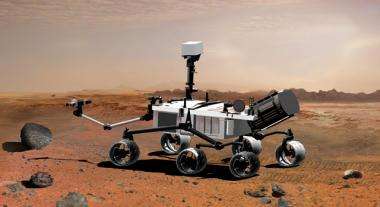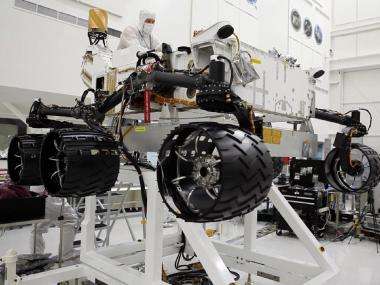Five things about NASA's Mars Curiosity rover

(PhysOrg.com) -- Mars Science Laboratory, aka Curiosity, is part of NASA's Mars Exploration Program, a long-term program of robotic exploration of the Red Planet. The mission is scheduled to launch from Cape Canaveral, Fla., in late 2011, and arrive at an intriguing region of Mars in August 2012.
The goal of Curiosity, a rolling laboratory, is to assess whether Mars ever had an environment capable of supporting microbial life and conditions favorable for preserving clues about life, if it existed. This will help us better understand whether life could have existed on the Red Planet and, if so, where we might look for it in the future.
1. How Big Is It?: The Mini Cooper-sized rover is much bigger than its rover predecessors, Spirit, Opportunity and Pathfinder. Curiosity is twice as long (about 2.8 meters, or 9 feet) and four times as heavy as Spirit and Opportunity, which landed in 2004. Pathfinder, about the size of a microwave oven, landed in 1997.
2. Landing--Where and How: In November 2008, possible landing sites were narrowed to four finalists, all linked to ancient wet conditions. NASA will select a site believed to be among the most likely places to hold a geological record of a favorable environment for life. The site must also meet safe-landing criteria. The landing system is similar to a sky crane heavy-lift helicopter. After a parachute slows the rover's descent toward Mars, a rocket-powered backpack will lower the rover on a tether during the final moments before landing. This method allows landing a very large, heavy rover on Mars (instead of the airbag landing systems of previous Mars rovers). Other innovations enable a landing within a smaller target area than previous Mars missions.
3. Toolkit: Curiosity will use 10 science instruments to examine rocks, soil and the atmosphere. A laser will vaporize patches of rock from a distance, and another instrument will search for organic compounds. Other instruments include mast-mounted cameras to study targets from a distance, arm-mounted instruments to study targets they touch, and deck-mounted analytical instruments to determine the composition of rock and soil samples acquired with a powdering drill and a scoop.

4. Big Wheels: Each of Curiosity's six wheels has an independent drive motor. The two front and two rear wheels also have individual steering motors. This steering allows the rover to make 360-degree turns in-place on the Mars surface. The wheels' diameter is double the wheel diameter on Spirit and Opportunity, which will help Curiosity roll over obstacles up to 75 centimeters (30 inches) high.
5. Rover Power: A nuclear battery will enable Curiosity to operate year-round and farther from the equator than would be possible with only solar power.
Provided by JPL/NASA





















